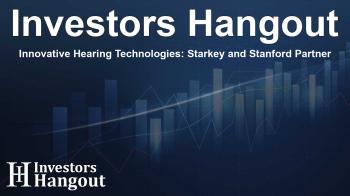Innovative Hearing Technologies: Starkey and Stanford Partner

Starkey's Commitment to Health and Innovation
Starkey, a leader in hearing technology, is pushing the envelope in innovation by partnering with esteemed researchers to enhance the capabilities of hearing aids. Their recent collaboration with Stanford has led to groundbreaking research published in a peer-reviewed journal focusing on fall risk detection using advanced balance assessment tools.
Addressing a Critical Issue: Falls Among Older Adults
Falls are recognized as one of the foremost causes of injury among older individuals. Starkey is committed to mitigating this risk through their innovative technology, which goes beyond simple hearing assistance. Their Balance Assessment feature, equipped with cutting-edge motion sensors and artificial intelligence (AI), is designed to evaluate various factors that contribute to the risk of falling.
How Balance Assessment Works
This advanced feature conducts a series of assessments using the My Starkey app, providing users with clear visual and audio instructions. By employing the Stopping Elderly Accidents, Deaths & Injuries (STEADI) protocol, the Balance Assessment encompasses a questionnaire alongside three functional balance tests. Starkey's hearing aids utilize built-in sensors to capture movement data, which the app processes to deliver results based on age-related benchmarks.
Collaboration with Stanford: A Step Forward in Fall Risk Detection
In a major advancement, the study led by Stanford utilized Starkey's Edge AI to validate the efficiency of the Balance Assessment feature. Researchers compared automated scoring generated by the hearing aids to evaluations conducted by trained healthcare professionals and found significant agreement between the two methods.
Expert Insights on the Findings
Dr. Kristen K. Steenerson from Stanford noted, "This study is a game-changer in fall risk assessment. We discovered that hearing aids embedded with motion sensors and AI can evaluate balance with precision on par with that of trained clinicians." This validation marks a critical shift in accessibility for fall prevention resources, particularly beneficial for individuals who may have limited access to healthcare facilities.
The Importance of Educating Patients
With the increasing recognition of hearing loss as a risk factor contributing to falls, Starkey strives to educate patients. By integrating balance assessment capabilities, Starkey encourages individuals to actively monitor their health and pursue additional evaluations when necessary. This proactive approach is particularly vital for patients in underserved regions where access to vestibular testing is limited.
Starkey's Legacy of Innovation
Known for its trailblazing approach, Starkey has introduced numerous health and wellness features into their hearing aids over the years. They were pioneers in incorporating 3D sensors alongside functionalities for step counting and social engagement tracking. Furthermore, Starkey stands out as the only hearing aid manufacturer to provide a fall detection and alert system, empowering users to take charge of their health and minimize their risk of falling.
Looking Ahead: The Future of Hearing Technology
The integration of AI and motion sensor technology into Starkey hearing aids is laying the groundwork for a future where falls can be effectively prevented. With Edge AI, the first self-guided balance assessment exercise is available within hearing aids themselves, illustrating Starkey's commitment to transforming healthcare accessibility.
Frequently Asked Questions
What is the main purpose of Starkey's Balance Assessment feature?
The Balance Assessment feature is designed to help identify individuals at higher risk of falling, encouraging them to pursue additional testing and evaluations.
How does the Balance Assessment technology work?
It uses advanced motion sensors and AI to assess balance and fall risk through the My Starkey app, incorporating a questionnaire and movement tests.
What were the findings of the study conducted with Stanford?
The study found a strong agreement between the automated scoring of the Balance Assessment feature and evaluations made by trained healthcare professionals.
Why is this technology significant for older adults?
This technology is crucial because it provides a means for older adults to self-monitor their balance, improving accessibility to fall prevention measures.
How has Starkey historically contributed to hearing technology?
Starkey has been a pioneer in incorporating health features into hearing aids, including step counting tools and fall detection systems, enhancing user health management.
About The Author
Contact Hannah Lewis privately here. Or send an email with ATTN: Hannah Lewis as the subject to contact@investorshangout.com.
About Investors Hangout
Investors Hangout is a leading online stock forum for financial discussion and learning, offering a wide range of free tools and resources. It draws in traders of all levels, who exchange market knowledge, investigate trading tactics, and keep an eye on industry developments in real time. Featuring financial articles, stock message boards, quotes, charts, company profiles, and live news updates. Through cooperative learning and a wealth of informational resources, it helps users from novices creating their first portfolios to experts honing their techniques. Join Investors Hangout today: https://investorshangout.com/
The content of this article is based on factual, publicly available information and does not represent legal, financial, or investment advice. Investors Hangout does not offer financial advice, and the author is not a licensed financial advisor. Consult a qualified advisor before making any financial or investment decisions based on this article. This article should not be considered advice to purchase, sell, or hold any securities or other investments. If any of the material provided here is inaccurate, please contact us for corrections.

